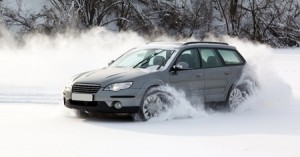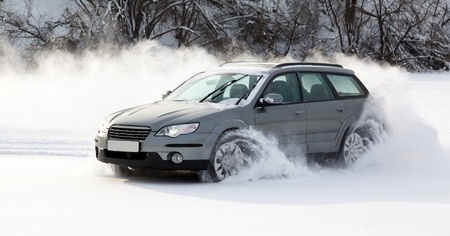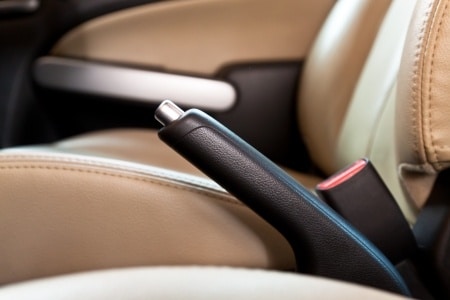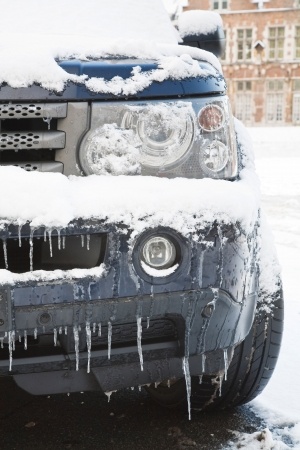Salt solutions are eating car paint, wires, gas tanks and more!
 Frostbite, earaches and school cancelations aren’t the only hassles that come with an excess of extreme winter weather.
Anytime rain, ice, sleet or snow falls from the sky, our vehicles are in danger of suffering permanent damage. This is due to what the Environmental Protection Agency calls “environmental fallout.”
Falling moisture contacts air pollution, dead bugs, bird poop and various pollens and saps and subsequently becomes saturated with these particles and pollutants. When this falling (newly polluted) moisture comes into contact with you vehicle, the result is drastic and long-term damage to your automotive paint.
When the falling moisture of the frozen or almost-frozen kind occurs, the odds are that your municipality or state will combat the freezing conditions by regularly spreading salt solutions on surfaces before and after a snow, ice or sleet event.
Because of its chemical composition, salt is a godsend in that it’s wonderfully effective at melting frozen water, keeping our walkways and roadways safe from slipperiness. But also because of its chemical composition, salt is a curse in that it’s wonderfully effective at dissolving paint, leaving our vehicles with ugly scars and scrapes. If you’re one of the many who must travel the saline streets in the land of the ice and snow, we have some great tips to help protect your vehicle from the ravages of road salt.
You do not need to worry too much about the exterior of your car, however, if you take the proper measures; the Department of Motor Vehicles has a few tips to keep salt from being a pain. They suggest washing and waxing your car prior to the weather event. A spit and polished vehicle is far less likely to be damaged because it rids the surface of any potentially damaging particles and protects it from the pollutants found in falling moisture. The DMV also recommends sealing the vehicle’s undercarriage (especially the brake and fuel lines). For more DMV tips, click here.
Unfortunately, according to experts, the exterior of your car isn’t the only thing at risk of being damaged by road salt mixes. This is because road salt is increasingly being mixed with finely ground synthetic compounds or even liquid solutions that contain shockingly corrosive properties. Whereas prior to these new salt mixes, granular road salt didn’t typically penetrate the interior of a vehicle, these mixes are now causing failures in wiring, fuel tanks and brakes and pretty much every aspect of a car’s inner workings.
If you think your car might have been damaged by these new salt mixes this winter or if you’ve been driving a lot and just want to avoid any potential inconvenient problems in the future, you should probably get it checked out by some professionals. After all, road salt mixes could be killing your car, inside and out!
Frostbite, earaches and school cancelations aren’t the only hassles that come with an excess of extreme winter weather.
Anytime rain, ice, sleet or snow falls from the sky, our vehicles are in danger of suffering permanent damage. This is due to what the Environmental Protection Agency calls “environmental fallout.”
Falling moisture contacts air pollution, dead bugs, bird poop and various pollens and saps and subsequently becomes saturated with these particles and pollutants. When this falling (newly polluted) moisture comes into contact with you vehicle, the result is drastic and long-term damage to your automotive paint.
When the falling moisture of the frozen or almost-frozen kind occurs, the odds are that your municipality or state will combat the freezing conditions by regularly spreading salt solutions on surfaces before and after a snow, ice or sleet event.
Because of its chemical composition, salt is a godsend in that it’s wonderfully effective at melting frozen water, keeping our walkways and roadways safe from slipperiness. But also because of its chemical composition, salt is a curse in that it’s wonderfully effective at dissolving paint, leaving our vehicles with ugly scars and scrapes. If you’re one of the many who must travel the saline streets in the land of the ice and snow, we have some great tips to help protect your vehicle from the ravages of road salt.
You do not need to worry too much about the exterior of your car, however, if you take the proper measures; the Department of Motor Vehicles has a few tips to keep salt from being a pain. They suggest washing and waxing your car prior to the weather event. A spit and polished vehicle is far less likely to be damaged because it rids the surface of any potentially damaging particles and protects it from the pollutants found in falling moisture. The DMV also recommends sealing the vehicle’s undercarriage (especially the brake and fuel lines). For more DMV tips, click here.
Unfortunately, according to experts, the exterior of your car isn’t the only thing at risk of being damaged by road salt mixes. This is because road salt is increasingly being mixed with finely ground synthetic compounds or even liquid solutions that contain shockingly corrosive properties. Whereas prior to these new salt mixes, granular road salt didn’t typically penetrate the interior of a vehicle, these mixes are now causing failures in wiring, fuel tanks and brakes and pretty much every aspect of a car’s inner workings.
If you think your car might have been damaged by these new salt mixes this winter or if you’ve been driving a lot and just want to avoid any potential inconvenient problems in the future, you should probably get it checked out by some professionals. After all, road salt mixes could be killing your car, inside and out!
 Frostbite, earaches and school cancelations aren’t the only hassles that come with an excess of extreme winter weather.
Anytime rain, ice, sleet or snow falls from the sky, our vehicles are in danger of suffering permanent damage. This is due to what the Environmental Protection Agency calls “environmental fallout.”
Falling moisture contacts air pollution, dead bugs, bird poop and various pollens and saps and subsequently becomes saturated with these particles and pollutants. When this falling (newly polluted) moisture comes into contact with you vehicle, the result is drastic and long-term damage to your automotive paint.
When the falling moisture of the frozen or almost-frozen kind occurs, the odds are that your municipality or state will combat the freezing conditions by regularly spreading salt solutions on surfaces before and after a snow, ice or sleet event.
Because of its chemical composition, salt is a godsend in that it’s wonderfully effective at melting frozen water, keeping our walkways and roadways safe from slipperiness. But also because of its chemical composition, salt is a curse in that it’s wonderfully effective at dissolving paint, leaving our vehicles with ugly scars and scrapes. If you’re one of the many who must travel the saline streets in the land of the ice and snow, we have some great tips to help protect your vehicle from the ravages of road salt.
You do not need to worry too much about the exterior of your car, however, if you take the proper measures; the Department of Motor Vehicles has a few tips to keep salt from being a pain. They suggest washing and waxing your car prior to the weather event. A spit and polished vehicle is far less likely to be damaged because it rids the surface of any potentially damaging particles and protects it from the pollutants found in falling moisture. The DMV also recommends sealing the vehicle’s undercarriage (especially the brake and fuel lines). For more DMV tips, click here.
Unfortunately, according to experts, the exterior of your car isn’t the only thing at risk of being damaged by road salt mixes. This is because road salt is increasingly being mixed with finely ground synthetic compounds or even liquid solutions that contain shockingly corrosive properties. Whereas prior to these new salt mixes, granular road salt didn’t typically penetrate the interior of a vehicle, these mixes are now causing failures in wiring, fuel tanks and brakes and pretty much every aspect of a car’s inner workings.
If you think your car might have been damaged by these new salt mixes this winter or if you’ve been driving a lot and just want to avoid any potential inconvenient problems in the future, you should probably get it checked out by some professionals. After all, road salt mixes could be killing your car, inside and out!
Frostbite, earaches and school cancelations aren’t the only hassles that come with an excess of extreme winter weather.
Anytime rain, ice, sleet or snow falls from the sky, our vehicles are in danger of suffering permanent damage. This is due to what the Environmental Protection Agency calls “environmental fallout.”
Falling moisture contacts air pollution, dead bugs, bird poop and various pollens and saps and subsequently becomes saturated with these particles and pollutants. When this falling (newly polluted) moisture comes into contact with you vehicle, the result is drastic and long-term damage to your automotive paint.
When the falling moisture of the frozen or almost-frozen kind occurs, the odds are that your municipality or state will combat the freezing conditions by regularly spreading salt solutions on surfaces before and after a snow, ice or sleet event.
Because of its chemical composition, salt is a godsend in that it’s wonderfully effective at melting frozen water, keeping our walkways and roadways safe from slipperiness. But also because of its chemical composition, salt is a curse in that it’s wonderfully effective at dissolving paint, leaving our vehicles with ugly scars and scrapes. If you’re one of the many who must travel the saline streets in the land of the ice and snow, we have some great tips to help protect your vehicle from the ravages of road salt.
You do not need to worry too much about the exterior of your car, however, if you take the proper measures; the Department of Motor Vehicles has a few tips to keep salt from being a pain. They suggest washing and waxing your car prior to the weather event. A spit and polished vehicle is far less likely to be damaged because it rids the surface of any potentially damaging particles and protects it from the pollutants found in falling moisture. The DMV also recommends sealing the vehicle’s undercarriage (especially the brake and fuel lines). For more DMV tips, click here.
Unfortunately, according to experts, the exterior of your car isn’t the only thing at risk of being damaged by road salt mixes. This is because road salt is increasingly being mixed with finely ground synthetic compounds or even liquid solutions that contain shockingly corrosive properties. Whereas prior to these new salt mixes, granular road salt didn’t typically penetrate the interior of a vehicle, these mixes are now causing failures in wiring, fuel tanks and brakes and pretty much every aspect of a car’s inner workings.
If you think your car might have been damaged by these new salt mixes this winter or if you’ve been driving a lot and just want to avoid any potential inconvenient problems in the future, you should probably get it checked out by some professionals. After all, road salt mixes could be killing your car, inside and out! 
 Frostbite, earaches and school cancelations aren’t the only hassles that come with an excess of extreme winter weather.
Anytime rain, ice, sleet or snow falls from the sky, our vehicles are in danger of suffering permanent damage. This is due to what the Environmental Protection Agency calls “environmental fallout.”
Falling moisture contacts air pollution, dead bugs, bird poop and various pollens and saps and subsequently becomes saturated with these particles and pollutants. When this falling (newly polluted) moisture comes into contact with you vehicle, the result is drastic and long-term damage to your automotive paint.
When the falling moisture of the frozen or almost-frozen kind occurs, the odds are that your municipality or state will combat the freezing conditions by regularly spreading salt solutions on surfaces before and after a snow, ice or sleet event.
Because of its chemical composition, salt is a godsend in that it’s wonderfully effective at melting frozen water, keeping our walkways and roadways safe from slipperiness. But also because of its chemical composition, salt is a curse in that it’s wonderfully effective at dissolving paint, leaving our vehicles with ugly scars and scrapes. If you’re one of the many who must travel the saline streets in the land of the ice and snow, we have some great tips to help protect your vehicle from the ravages of road salt.
You do not need to worry too much about the exterior of your car, however, if you take the proper measures; the Department of Motor Vehicles has a few tips to keep salt from being a pain. They suggest washing and waxing your car prior to the weather event. A spit and polished vehicle is far less likely to be damaged because it rids the surface of any potentially damaging particles and protects it from the pollutants found in falling moisture. The DMV also recommends sealing the vehicle’s undercarriage (especially the brake and fuel lines). For more DMV tips, click here.
Unfortunately, according to experts, the exterior of your car isn’t the only thing at risk of being damaged by road salt mixes. This is because road salt is increasingly being mixed with finely ground synthetic compounds or even liquid solutions that contain shockingly corrosive properties. Whereas prior to these new salt mixes, granular road salt didn’t typically penetrate the interior of a vehicle, these mixes are now causing failures in wiring, fuel tanks and brakes and pretty much every aspect of a car’s inner workings.
If you think your car might have been damaged by these new salt mixes this winter or if you’ve been driving a lot and just want to avoid any potential inconvenient problems in the future, you should probably get it checked out by some professionals. After all, road salt mixes could be killing your car, inside and out!
Frostbite, earaches and school cancelations aren’t the only hassles that come with an excess of extreme winter weather.
Anytime rain, ice, sleet or snow falls from the sky, our vehicles are in danger of suffering permanent damage. This is due to what the Environmental Protection Agency calls “environmental fallout.”
Falling moisture contacts air pollution, dead bugs, bird poop and various pollens and saps and subsequently becomes saturated with these particles and pollutants. When this falling (newly polluted) moisture comes into contact with you vehicle, the result is drastic and long-term damage to your automotive paint.
When the falling moisture of the frozen or almost-frozen kind occurs, the odds are that your municipality or state will combat the freezing conditions by regularly spreading salt solutions on surfaces before and after a snow, ice or sleet event.
Because of its chemical composition, salt is a godsend in that it’s wonderfully effective at melting frozen water, keeping our walkways and roadways safe from slipperiness. But also because of its chemical composition, salt is a curse in that it’s wonderfully effective at dissolving paint, leaving our vehicles with ugly scars and scrapes. If you’re one of the many who must travel the saline streets in the land of the ice and snow, we have some great tips to help protect your vehicle from the ravages of road salt.
You do not need to worry too much about the exterior of your car, however, if you take the proper measures; the Department of Motor Vehicles has a few tips to keep salt from being a pain. They suggest washing and waxing your car prior to the weather event. A spit and polished vehicle is far less likely to be damaged because it rids the surface of any potentially damaging particles and protects it from the pollutants found in falling moisture. The DMV also recommends sealing the vehicle’s undercarriage (especially the brake and fuel lines). For more DMV tips, click here.
Unfortunately, according to experts, the exterior of your car isn’t the only thing at risk of being damaged by road salt mixes. This is because road salt is increasingly being mixed with finely ground synthetic compounds or even liquid solutions that contain shockingly corrosive properties. Whereas prior to these new salt mixes, granular road salt didn’t typically penetrate the interior of a vehicle, these mixes are now causing failures in wiring, fuel tanks and brakes and pretty much every aspect of a car’s inner workings.
If you think your car might have been damaged by these new salt mixes this winter or if you’ve been driving a lot and just want to avoid any potential inconvenient problems in the future, you should probably get it checked out by some professionals. After all, road salt mixes could be killing your car, inside and out! 

